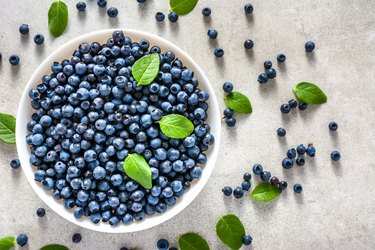
Blueberries seem to top every list of the most healthful foods — full of micronutrients and a good amount of fiber. Since fiber is connected to colon health, and diverticulitis is connected to a lack of fiber, does this mean it's always a good time to eat blueberries? Here's what you need to know.
Video of the Day
Video of the Day
Understanding Diverticular Disease
According to the National Institute of Diabetes and Digestive and Kidney Diseases (NIDDK), diverticular disease includes diverticulosis and diverticulitis — but you have to have diverticulosis before you can have diverticulitis.
"Diverticulosis is the formation of sacs or pockets, called diverticula, that push through the wall of your colon," says Susanne Shokoohi, MD, an assistant professor of gastroenterology at Loyola University Medical Center in Maywood, Illinois. "I describe them as little caves in the colon. They can form anywhere in the colon, but they are most common on the left side."
"Diverticulosis is very common in older age," she says. "By age 60, about 60 percent of people have diverticulosis."
The condition increases with age because the muscular wall of your colon — the last part of your digestive tract, where water is absorbed and stools are formed — becomes weaker over time. In fact, by age 85, two-thirds of Americans have diverticulosis, according to Harvard Health Publishing.
Other risk factors for diverticulosis are being overweight, eating a low-fiber diet, having a family history of diverticular disease and being a smoker.
Most people with diverticulosis have no symptoms, says Dr. Shokoohi. When symptoms do develop, they may involve constipation, diarrhea, bloating or abdominal pain, according to the NIDDK.
The Progression to Diverticulitis
Diverticulitis occurs when diverticula become inflamed or infected. This does cause symptoms that can include pain, fever, chills, nausea or vomiting, according to the NIDDK. It's also possible for bleeding into your colon to occur if small blood vessels inside diverticula rupture. The bleeding can range from mild to severe, says Harvard Health Publishing.
"Bleeding may be painless and heavy when you pass stool," says Dr. Shokoohi. But, "any bleeding should trigger a call to your doctor, and heavy bleeding should trigger a 911 call."
Stopping Diverticular Disease With Diet
"It was once thought that diverticulitis was caused by a seed or a piece of a nut or corn kernel getting stuck inside diverticula and causing irritation and infection," says Dr. Shokoohi. "We now know that this is not the cause. The real cause is probably a small rupture inside the diverticula, called a microperforation, that leads to inflammation and possibly a bacterial infection."
"The fear that seeds in blueberries can cause diverticulitis is outdated and counterproductive," she says. "Fruits and berries can be healthy foods for people with diverticular disease."
You don't need to avoid popcorn, nuts, seeds or any other type of high-fiber food, unless you find that it seems to make your symptoms worse, states the NIDDK. If you have been diagnosed with diverticulosis or have had a bout of diverticulitis, you may be able to prevent diverticulitis or a recurrence by increasing fiber in your diet.
According to Harvard Health Publishing, the recommended amount of fiber for men up to age 50 is 38 grams a day and 30 grams a day after age 50. For women, it's 30 grams a day up to age 50 and 21 grams a day after age 50. To help you reach your fiber goal, your doctor may prescribe a fiber supplement, like methylcellulose or psyllium, to take one to three times a day along with a glass of water.
"The best diet for diverticulitis is a diet that includes plenty of healthy fiber from fruits, including blueberries and other berries," says Dr. Shokoohi. "Vegetables, nuts and whole grains are the other good sources of fiber."
The only time you may need to avoid blueberries and other foods in general is during an active attack of diverticulitis. "Treatment for an attack may include going on a liquid diet for a few days along with seven to 10 days on an antibiotic," she says. "As your symptoms improve, you can gradually return to a normal diet."
Read more: Meals to Eat With Diverticulitis
- Susanne Shokoohi, MD, assistant professor, gastroenterology, Loyola University Medical Center, Maywood, Illinois
- National Institute of Diabetes and Digestive and Kidney Diseases: "Definition and Facts for Diverticular Disease"
- National Institute of Diabetes and Digestive and Kidney Diseases: "Symptoms and Causes of Diverticular Disease"
- National Institute of Diabetes and Digestive and Kidney Diseases: "Treatment for Diverticular Disease"
- Harvard Health Publishing: "Diverticular Disease of the Colon"
Is this an emergency? If you are experiencing serious medical symptoms, please see the National Library of Medicine’s list of signs you need emergency medical attention or call 911.